Chapter 10.62
UNMANNED AIRCRAFT SYSTEMS
Sections:
10.62.050 Violation – Penalty – Allowed measures to enforce.
10.62.060 Impoundment and forfeiture.
10.62.010 Purpose.
Unmanned aircraft systems (UAS) have the potential to be operated in a manner that poses a threat to the citizens of Kitsap County. “Threat” means a reasonable likelihood of: unauthorized surveillance; unauthorized access to or disclosure of classified or otherwise lawfully protected information; disruption of or damage to a communication system; interference with a covered government operation; or delivery or carriage of weapons, explosives, or other hazardous materials. To help protect the security of our military installations and their operations and provide increased buffering and response times, Kitsap County Code limits the use of UAS as detailed in this chapter.
(Ord. 571 (2019) § 4 (part), 2019)
10.62.020 Definitions.
For the purpose of this chapter, the following terms, phrases, words and their derivatives shall be construed as specified in this section. Where terms, phrases and words are not defined, they shall have their ordinary accepted meanings within the context with which they are used. The most current version of the English Webster’s Dictionary shall be considered as providing ordinary accepted meanings.
A. “Civil unmanned aircraft systems” shall mean an unmanned aircraft or unmanned aircraft system operated by any person for purposes including, but not limited to, hobby or recreational, commercial and/or in furtherance of, or incidental to, any business or media service or agency.
B. “Public unmanned aircraft systems” shall mean an unmanned aircraft or unmanned aircraft system operated by any military, public law enforcement, public safety or civil engineering agency, or their agents, for government-related purposes.
C. “Land” shall mean the returning of any UAS or model airplane to the ground after a flight of any duration.
D. “Launch” shall mean the automated lifting of any UAS or model airplane from the ground for a flight of any duration.
E. “Military installation” shall mean all land within base boundaries of Naval Base Kitsap-Bremerton, Naval Base Kitsap-Bangor, Naval Base Kitsap-Keyport, Naval Hospital Bremerton and Naval Base Kitsap-Manchester.
F. “Military installation protection overlay area” shall mean a general three-thousand-foot area measured from the property boundary of any military installation as shown in Section 10.62.030.
G. “Unmanned aircraft” shall mean an aircraft including, but not limited to, an aircraft commonly known as a drone or model airplane, that is operated without the possibility of direct human intervention from within or on the aircraft.
H. “Unmanned aircraft system” shall mean an unmanned aircraft and associated elements including, but not limited to, any communication links and components that control the unmanned aircraft.
(Ord. 571 (2019) § 4 (part), 2019)
10.62.030 Prohibitions.
No person shall launch or land any civil unmanned aircraft system, including those classified by the FAA as model aircraft, within military installation protection overlay areas. The specific boundaries of such overlay areas are shown below (subsections (A) through (E) of this section). These prohibitions apply to the areas in the military installation protection overlay areas and do not apply to operations approved by FAA and Naval Base Kitsap on installation property.
A. Naval Base Kitsap – Bangor.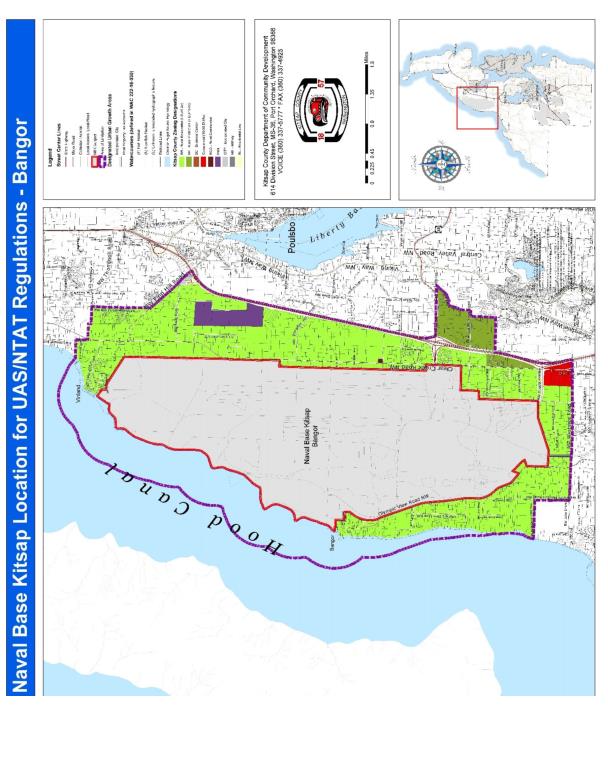
B. Naval Base Kitsap – Keyport.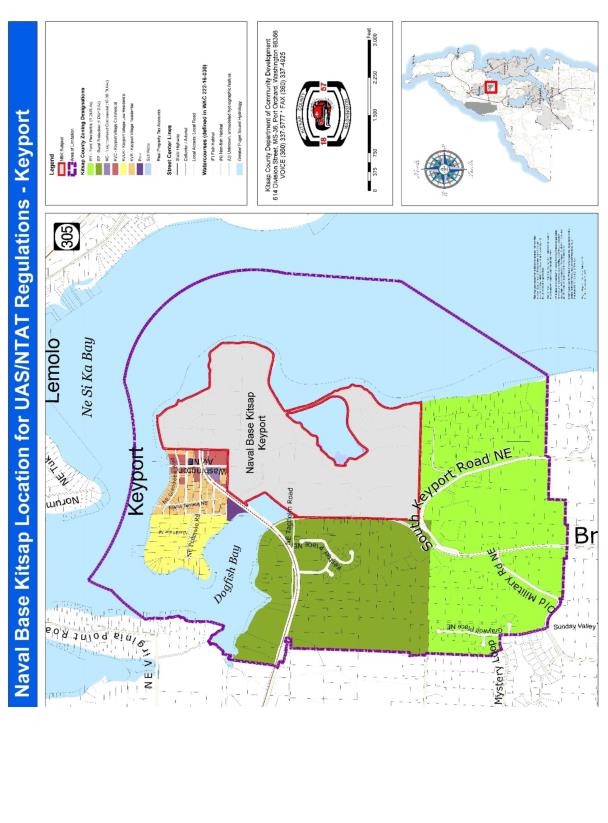
C. Naval Base Kitsap – Naval Hospital.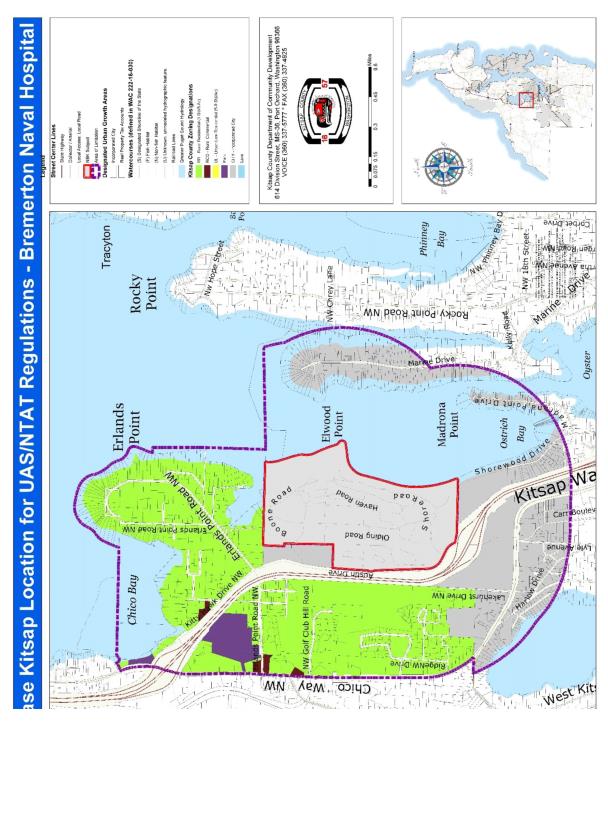
D. Naval Base Kitsap – Bremerton.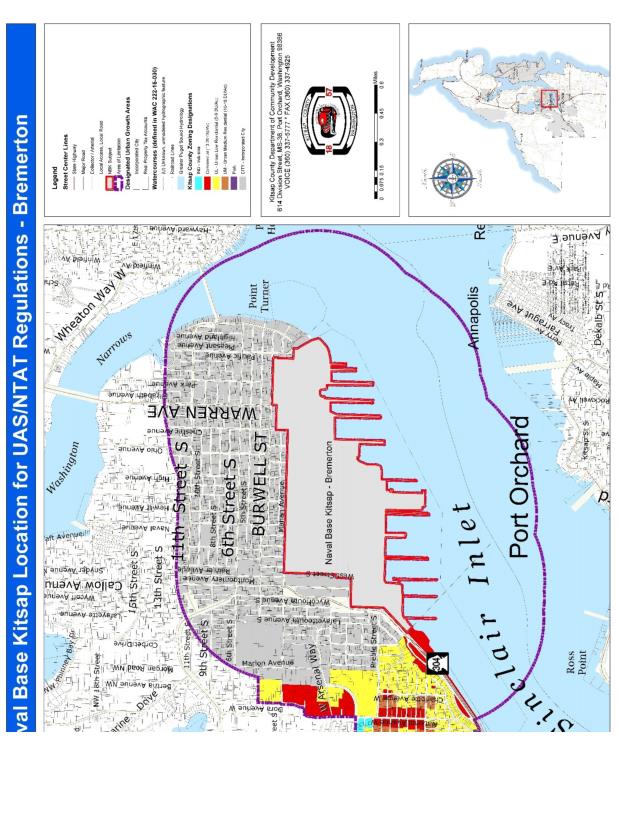
E. Naval Base Kitsap – Manchester.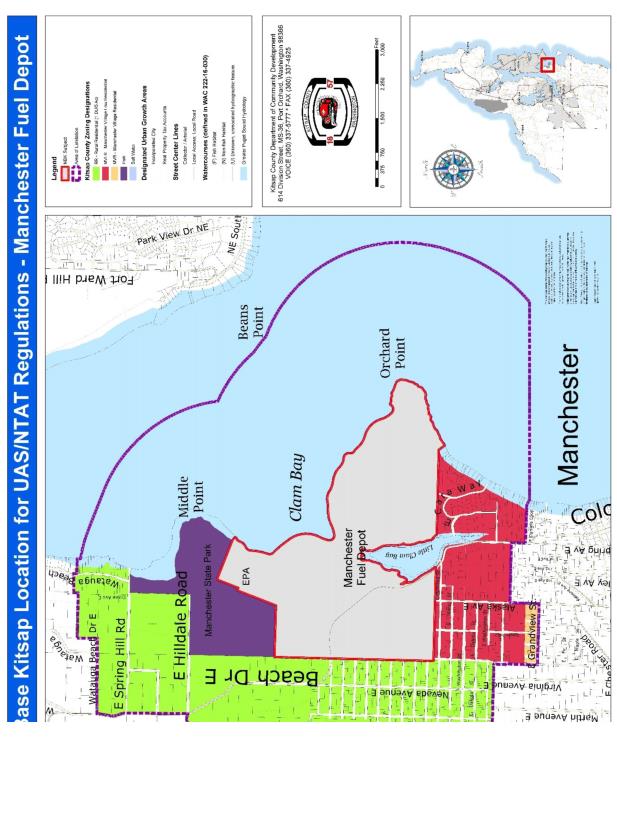
(Ord. 571 (2019) § 4 (part), 2019)
10.62.040 Exemptions.
These exemptions shall only apply to the launching and landing of UAS in Kitsap County jurisdiction and do not authorize their use over military installations or within the military installation property boundaries. Those authorizations are to be separately approved by FAA and Naval Base Kitsap.
A. All public unmanned aircraft systems are exempt from this chapter.
B. All civil unmanned aircraft systems may be approved for either a short-term or blanket exemption upon application to Kitsap County prior to flight as provided herein. The county shall provide an electronic means for submitting short-term exemption applications.
1. Short-Term Exemption. A short-term exemption will allow the launching and landing of UAS within a military installation protection overlay area for a period of up to twelve hours. Each application must include:
a. Physical address of the specific property(s) the UAS shall be launched from and landed upon.
b. Name of the applicant.
c. Contact information including phone number, email and mailing address of the applicant.
d. Date and time of the proposed flight.
e. Purpose of the UAS flight(s).
f. Drone manufacturer.
g. FAA registration number.
h. Acknowledgment of FAA and U.S. military rules regarding flights over military installations or other no-fly zones.
Once a complete application is submitted, the U.S. Navy and sheriff shall be electronically notified and the applicant may launch immediately.
2. Blanket Exemption. A blanket exemption shall allow the launching and landing of UAS for goods or merchandise transport by a business or commercial venture with a valid Washington State business license and an approved FAA registration within a military installation protection overlay area for a period of up to two years. Blanket exemptions may be renewed for additional two-year periods beginning ninety days before their expiration.
(Ord. 571 (2019) § 4 (part), 2019)
10.62.050 Violation – Penalty – Allowed measures to enforce.
As authorized by RCW 36.32.120(7), any person who violates the provisions of this chapter may be charged with a misdemeanor and upon conviction may be imprisoned for up to sixty days and be subject to a fine of not more than $1,000.00. Law enforcement retains their discretion to issue a warning in appropriate circumstances.
With the exception of federal property within the boundaries of military installations, a law enforcement officer is authorized to take the following actions to enforce this chapter where allowed by federal and state law:
A. Detect, identify, monitor, and track an unmanned aircraft system, unmanned aircraft, or unmanned aircraft’s attached system, payload, or cargo, to determine if it poses a threat to a military installation, its assets or operations, without prior consent.
B. Disable or disrupt control of the operation of an unmanned aircraft system, unmanned aircraft, or unmanned aircraft’s attached system, payload, or cargo that poses an imminent threat to a military installation, its assets or operations without prior consent.
C. Seize or exercise control over an unmanned aircraft system, unmanned aircraft, or unmanned aircraft’s attached system, payload, or cargo that poses an imminent threat to a military installation, its assets or operations without prior consent.
D. Interdict or otherwise confiscate an unmanned aircraft system, unmanned aircraft, or unmanned aircraft’s attached system, payload, or cargo that is operating in an overlay area if an imminent threat to a military installation, its assets or operations without prior consent.
(Ord. 571 (2019) § 4 (part), 2019)
10.62.060 Impoundment and forfeiture.
An unmanned aircraft system, unmanned aircraft, or unmanned aircraft’s attached system, payload, or cargo that is in violation of this chapter and is seized, confiscated, disrupted, disabled or interdicted pursuant to Section 10.62.050 may be subject to impoundment and forfeiture where allowed by federal or state law.
(Ord. 571 (2019) § 4 (part), 2019)


